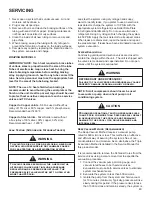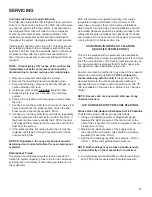
SERVICING
50
condensing unit. If using evaporator coils or air handlers
other than HSVTC coil it may be necessary to add or
remove refrigerant to attain proper charge. If line set
exceeds 15 feet in length, refrigerant should be added at .6
ounces per foot of liquid line.
NOTE: The outdoor temperature should be 60°F or
higher when charging the unit.Charge should always
be checked using subcooling when using TXV
equipped indoor coil to verify proper charge.
When opening valves with retainers, open each valve
only until the top of the stem is 1/8” from the retainer. To
avoid loss of refrigerant, DO NOT apply pressure to the
retainer. When opening valves without a retainer remove
service valve cap and insert a hex wrench into the valve
stem and back out the stem by turning the hex wrench
counterclockwise. Open the valve until it contacts the rolled
lip of the valve body.
NOTE: These are not back-seating valves. It is not
necessary to force the stem tightly against the rolled
lip.
Break vacuum by fully opening liquid service valve.
After the refrigerant charge has bled into the system,
open the suction service valve. The service valve cap is
the secondary seal for the valves and must be properly
tightened to prevent leaks. Make sure cap is clean and
apply refrigerant oil to threads and sealing surface on
inside of cap. Tighten cap finger-tight and then tighten
additional 1/6 of a turn (1 wrench flat), or to the following
specification, to properly seat the sealing surfaces.
EXPANSION VALVE SYSTEM
NOTE: Units matched with indoor coils equipped with
non-adjustable TXV should be charged by subcooling
only.
NOTE: The TXV should NOT be adjusted at light load
conditions 55º to 60ºF. Use the following guidelines
and methods to check unit operation and ensure that
the refrigerant charge is within limits. Charge the unit
on low stage.
Final Charge Adjustment
Airflow and Total Static Pressure for the indoor unit should
be verified before attempting to charge system.
1. Total static pressure is .5” WC or less.
2.
Airflow is correct for installed unit.
3.
Airflow tables are in the installation manual and Spec
Sheet for Indoor Unit.
4. Complete charging information are in Service Manual
RS6200006
NOTE: Superheat adjustments should not be made
until indoor ambient conditions have stabilized.
This could take up to 24 hours depending on indoor
temperature and humidity. Before checking superheat
run the unit in cooling for 10-15 minutes or until
refrigerant pressures stabilize. Use the following
guidelines and methods to check unit operation and
ensure that the refrigerant charge is within limits.
Units matched with indoor coils equipped with a non-
adjustable TXV should be charged by Subcooling only.
Superheat on indoor coils with adjustable TXV valves are
factory set and no adjustment is normally required during
startup. Only in unique applications due to refrigerant
line length, differences in height between the indoor
and outdoor unit and refrigerant tubing sizes or poor
performance should Superheat setting require adjustment.
These adjustments should only be performed by
qualified service personnel. For detailed charge and TXV
adjustments refer to the appropriate Service Manual.
Units Equipped with Adjustable Expansion Valves
should be charged by Subcooling and Superheat
adjusted only if necessary.
1. Purge gauge lines. Connect service gauge manifold to
base-valve service ports. Run the system in low stage
at least 10 minutes to allow pressure to stabilize.
2. Temporarily install a thermometer on the liquid line
at the liquid line service valve and 4-6” from the
compressor on the suction line. Ensure the thermometer
makes adequate contact and is insulated for best
possible readings. Use liquid line temperature to
determine subcooling and vapor temperature to
determine superheat.
3. Check subcooling and superheat. Systems with TXV
application should have a subcooling of 5 to 7°F and
superheat of 7 to 9 °F.
A. If subcooling and superheat are low, adjust TXV to 7
to 9 ºF superheat, and then check subcooling.
NOTE: To adjust superheat, turn the valve stem
clockwise to increase and counter clockwise to
decrease.
B. If subcooling is low and superheat is high, add
charge to raise subcooling to 5 to 7 °F then check
superheat.
C. If subcooling and superheat are high, adjust
TXV valve to 7 to 9 ºF superheat, then check
subcooling.
D. If subcooling is high and superheat is low, adjust TXV
valve to 7 to 9 ºF superheat and remove charge to
lower the subcooling to 5 to 7 ºF.
NOTE: Do NOT adjust the charge based on suction
pressure unless there is a gross undercharge.
Summary of Contents for ASXC16
Page 4: ...PRODUCT IDENTIFICATION 4 ...
Page 5: ...PRODUCT IDENTIFICATION 5 ...
















































